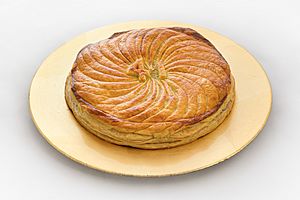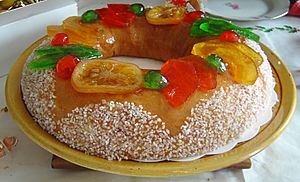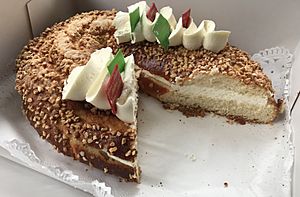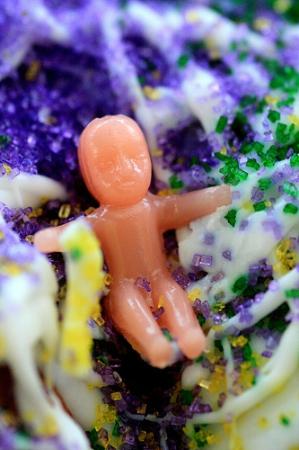King cake facts for kids
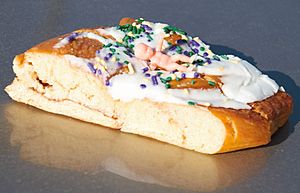
Part of a Louisiana-style king cake with the baby figurine on top
|
|
| Type | Cake |
|---|---|
| Similar dishes |
|
A king cake is a special cake enjoyed in many countries, especially around a holiday called Epiphany. This holiday is also known as "Three Kings' Day." King cakes come in different shapes and with different ingredients.
Often, a small figurine or fève (which means 'bean' in French) is hidden inside the cake. This figurine often looks like the Christ Child. When the cake is cut, the person who finds the fève usually wins a prize or gets a special role for the day! Today, these hidden figurines can be made of different materials and represent many things.
Contents
What is the History of King Cake?
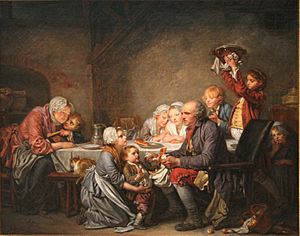
The king cake gets its name from the Biblical Magi, who are often called the "three kings." In many Christian traditions, Epiphany celebrates when these wise men visited the Christ Child. The night before Epiphany is called Twelfth Night. This is the last day of the Christmas season.
King cakes first appeared in Europe during the Middle Ages. French settlers then brought the tradition to America. Finding the hidden figurine in the cake is thought to bring good luck. People enjoy king cakes from Epiphany until the first day of Lent, which is Ash Wednesday.
Different Kinds of King Cakes Around the World
King cakes are made differently depending on where you are. Let's explore some of the regional styles!
King Cakes in France and Belgium
In northern France, Quebec, and Belgium, the cake is called galette des rois in French. In most of France, it's a puff pastry cake filled with a creamy almond paste called frangipane.
When you buy a king cake, it often comes with a paper crown. The person who finds the hidden fève gets to wear the crown and becomes the "king" or "queen" for the day! To make sure it's fair, the youngest person often sits under the table. As each piece of cake is cut, they call out who should get it without seeing the pieces.
King Cakes in Germany and Switzerland
In German-speaking countries like Germany and Switzerland, the king cake is called Dreikönigskuchen. This means 'Three King Cake'. These cakes are usually shaped like wreaths or round loaves of bread. Instead of a figurine, they often hide an almond inside as the fève.
King Cakes in Portugal
In Portugal, the traditional king cake is called Bolo-rei. This cake is eaten from early December until Epiphany. The recipe for Bolo-rei came from the French galette des rois in the 1800s.
The Bolo-rei is round with a large hole in the middle, making it look like a crown. It's covered with colorful candied and dried fruits. The cake is made from a soft, white dough with raisins and different nuts. It also has a dried fava bean hidden inside. The tradition says that whoever finds the fava bean has to buy the cake for next year!
King Cakes in Spanish-Speaking Countries
The roscón de reyes is a popular king cake in Spain and other Hispanic countries like Mexico. The recipes can be a bit different in each place, but they are usually similar. These cakes are often oval-shaped so they can be big enough for many people. They are decorated with fruits like figs, quinces, cherries, or other dried and candied fruits.
Like other king cakes, the roscón de reyes has a hidden bean, candy, or a small figurine of the Child Jesus. Finding the baby Jesus figurine is seen as a blessing. The person who finds it traditionally takes the figurine to the nearest church on Candlemas Day or hosts a party on that day.
A special version of the Spanish roscón is the "crown of the Almudena" (corona de la Almudena). This cake is linked to Madrid. It's a smaller roscón that doesn't have liquor or lemon/orange peel. Instead, it's covered with an orange-juice syrup. This cake doesn't have prizes or beans inside. It's usually sold around November 9, which is the day of Our Lady of Almudena, the patron saint of Madrid. It often comes with a cardboard crown.
King Cakes in the United States
In the American South, especially in Louisiana and the Gulf Coast area, king cake is a big part of Mardi Gras celebrations. It's served during Carnival and sometimes all year. It might have been brought by settlers from France or the Basque region.
American king cakes come in many styles. The simplest and most traditional is a ring of twisted dough, similar to a cinnamon roll. It can be topped with icing or sugar. The sugar is often colored purple, green, and gold. These colors have special meanings for Mardi Gras: purple for justice, green for faith, and gold for power.
King cakes can also have fillings like cream cheese, praline, cinnamon, or strawberry. The "Zulu King Cake" has chocolate icing and a coconut filling.
Traditionally, a small porcelain baby figurine, symbolizing Jesus, is hidden inside the king cake. Finding it is a way for people in New Orleans to celebrate their Christian faith. The baby is a symbol of luck and good fortune. The person who finds it is also usually responsible for buying next year's cake or hosting the next Mardi Gras party. Some bakers now place the baby outside the cake to avoid any choking risks.
In 2009, the New Orleans Pelicans basketball team even introduced a "King Cake Baby" as a mascot!
King Cakes in the United Kingdom
The Twelfth Cake, or Twelfth-night cake, used to be very popular in the United Kingdom on Twelfth Night. It often had a bean hidden on one side and a pea on the other. The man who found the bean became the "King" for the night, and the woman who found the pea became the "Queen." They were also known as the Lord or Lady of Misrule.
While you can still find king cakes sometimes in the United Kingdom, they became less popular after the Industrial Revolution. The celebration of the 12 days of Christmas changed, and the Twelfth Cake was often replaced by the Christmas cake.
Gallery
See also
 In Spanish: Galette des Rois para niños
In Spanish: Galette des Rois para niños


